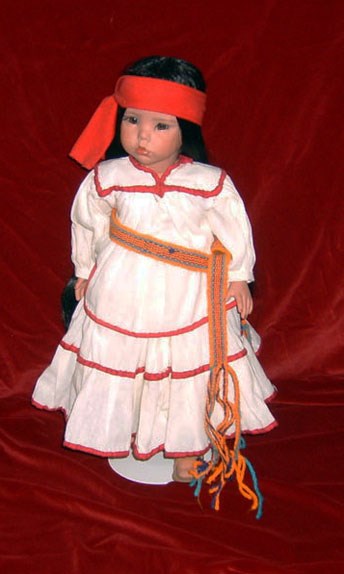
Capital: Chihuahua The Tarahumaras, or Raramuris, as they call themselves, are concentrated in the Sierra Tarahumara (part of the Sierra Madre Occidental) in southwestern Chihuahua, which extends into northern Durango and Sinaloa. Typically, their clothing includes a short cotton blouse over a wide, ruffled skirt adorned with bright appliqué in contrasting colors. Sometimes, several skirts are worn one over the other. The belt, or natepare, is made of woven raw wool or cotton. The head sash is called a coyera, or a koiera napola. The Tarahumara are known for their remarkable physical stamina as long-distance, often barefooted runners. In fact, the word "Raramuri" means "man who walks well", or "the light-footed one". Further south, in the Sierra del Nayar, in northern Nayarit, live the Coras and Huicholes, known for the beauty of their ancient apparel. Although some part of these indigenous groups have left the mountain seeking sustenance in urban areas, many have remained in their remote homes, adhering closely to their traditions, withstanding drought and famine, cultivating corn, beans and squash. Chihuahua is Mexico's largest state, and its history includes on of Mexico's most notorious figures. Although he was born in Durango and died in Parral on June 20, 1923, Doroteo Arango Arámbula, also know as Francisco, or "Pancho" Villa, made his mark in northern Chihuahua. Villa was the leading revolutionary in the effort to gain Mexico's independence that began in 1910. The state's dramatic landscape features rugged peaks with volcanic outcroppings (many with rich ore deposits) and narrow passes, including Cañon del Cobre (Copper Canyon) and the Barranca de Urique, which is over a kilometer deep and holds Mexico's highest waterfall, the 311-meter tall Cascade de Basaseachic. Chihuahua is famous for its beef cattle, lumber production, and fruit crops - juicy peaches, more than 30 varieties of apples, delicious nuts and melons. Did you know...?In 1533, Alvar Núñez Cabeza de Vaca became the first Spaniard to cross Chihuahua; he described the region as a fantastic kingdom in the north of New Spain. In 1562, Francisco Ibarra began an expedition to the lands now occupied by the states of Durango, Coahuila, and Chihuahua. In line with Spanish tradition, the practice of giving the names of the places the Conquistadors came from to newly discovered or founded settlements, the called the lands he took in the name of the Spanish crown, New Biscay. Chihuahua later ceased to belong to New Biscay and became part of the province of Durango. In 1823, it was declared an independent province, and finally became a free and sovereign state. 
Capital: Chihuahua Los Tarahumaras o Raramuris, están concentrados en la Sierra Tarahumara (parte de la Sierra Madre Occidental) en el suroeste de Chihuahua, que se extiende hacia el norte de Durango y Sinaloa. Básicamente su vestimenta consiste en una falda amplia plisada adornada por brillantes aplicaciones en colores contrastantes. En ocasiones, utilizan varias faldas (una sobre otra). El cinturón o natepare, esta hecho de lana tejida cruda o de algodón. La faja que cubre la frente de sus cabezas se llama coyera o koiera napola. Los Tarahumaras son conocidos por su notable resistencia física en carreras de grandes distancias y a menudo descalzos. De hecho, la palabra Raramuri significa "hombre que anda bien" o "ligero de pies". Chihuahua es el estado mexicano más grande y en su historia se encuentra una de las figuras más notorias de México, Doroteo Arango Arámbula, mejor conocido como Pancho Villa, aunque nació en Durango, dejó su huella para la posteridad en el norte del estado de Chihuahua. El dramático paisaje del estado se caracteriza por sus cadenas montañosas con afloramientos volcánicos (muchos con yacimientos ricos en minerales) y estrechos cañones, como las Barrancas del Cobre y de Urique, la cual mide casi 1600 metros de profundidad, en ella se encuentra la Cascada de Basaseachi que tiene 311 metros de altura. Chihuahua es famosa por su ganado de engorda, la producción de madera y cosecha de fruta, jugosos duraznos, más de 30 variedades de manzana, deliciosas nueces y melones. Sabías que...? |
Last updated: February 24, 2015
